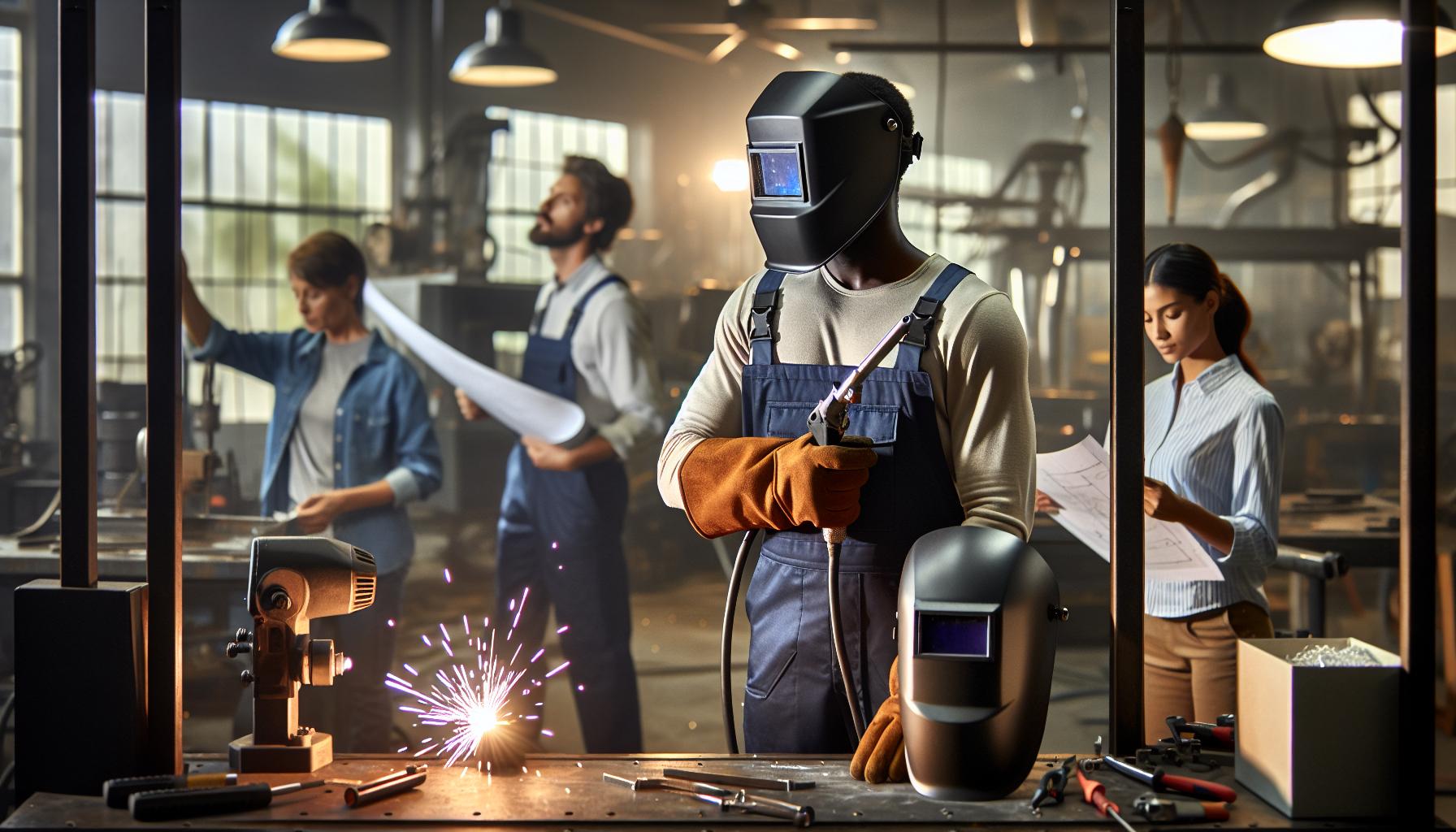Welding is a critical skill in today’s manufacturing and construction industries, essential for creating strong, lasting bonds in metal fabrication. Did you know that skilled welders are in high demand, with job opportunities projected to grow significantly in the coming years? Obtaining a welding certification can be your ticket to securing a profitable and fulfilling career. In this comprehensive 2025 guide, you’ll discover the fastest pathways to certification, including essential techniques like MIG, TIG, and stick welding. We’ll also cover safety protocols, materials such as aluminum and steel, and the equipment you’ll need to succeed. Whether you’re a novice eager to start your journey or an experienced welder looking to enhance your credentials, this guide will equip you with the knowledge and confidence to achieve your certification swiftly. Read on to unlock the steps that will propel your welding career forward.
Understanding Welding Certification Types and Levels

Welding certification is an essential credential that validates a welder’s skills and knowledge in various welding techniques and applications. With the construction and manufacturing industries booming, the demand for certified welders is at an all-time high. Understanding the different types and levels of welding certifications is crucial for anyone looking to enhance their career prospects in this field.
The most recognized certifications are offered by bodies such as the American Welding Society (AWS) and the American Society of Mechanical Engineers (ASME). Certifications vary significantly, reflecting different skill levels and specializations. For instance, the Certified Welder (CW) certification is a performance-based credential that allows welders to demonstrate their competencies in specific welding processes, such as MIG (Metall argon gas) and TIG (Tungsten Inert Gas). In contrast, the Certified Welding Inspector (CWI) certification focuses on the ability to evaluate welds and ensure compliance with industry standards, making it more suitable for those aspiring to supervisory roles.
Another key certification is the Certified Robotic Arc Welding (CRAW), which merges traditional welding knowledge with the skills needed for modern automated systems. This certification is increasingly important as automation becomes a mainstay in manufacturing settings. The landscape of welding certifications is vast, including options like the Certified Welding Educator (CWE) for those looking to teach and train future welders, as well as specialized programs that cater to niche sectors like pipelines and structural welding.
Investing time in understanding these certifications and their respective requirements can significantly influence one’s career trajectory. For instance, individuals seeking entry-level positions may initially obtain basic certifications, while seasoned professionals might pursue advanced credentials to specialize in particular techniques or industry sectors. By mapping out a strategic plan for certification, welders can not only improve their skills but also enhance their job marketability in a competitive landscape.
Essential Requirements for Welding Certification

To succeed in obtaining welding certification, it’s essential to understand the foundational requirements that underpin this process. Certification serves as a marker of quality, ensuring that welders possess the skills and knowledge necessary to perform tasks safely and effectively. One of the primary requirements is proper training, which typically occurs in vocational schools or community colleges where students can learn various welding techniques, including MIG (Metal Inert Gas), TIG (Tungsten Inert Gas), stick welding, and flux-cored welding. A strong educational foundation fosters not only technical skills but also an understanding of different materials, such as aluminum and steel, which is crucial for a welder’s versatility.
In addition to formal training, hands-on experience plays a pivotal role in preparation for certification. Many programs require students to complete a set number of hours practicing welding under the supervision of qualified instructors. This practical exposure helps learners become familiar with welding equipment, safety protocols, and the nuances of different welding techniques. Furthermore, aspiring welders should prepare for the specific certification tests they intend to take. Comprehensive study materials and practice tests are often available through training institutions or welding organizations, enabling candidates to familiarize themselves with exam formats and content.
Safety standards are another critical component of welding certification. Candidates must demonstrate knowledge of safety procedures applicable to various welding environments. Topics such as personal protective equipment (PPE), safe equipment handling, and emergency response protocols need to be understood thoroughly. Some certifying bodies may also require completion of safety courses, ensuring that all certified welders prioritize safety on the job.
Finally, documentation plays a crucial role throughout the certification process. Applicants should be prepared to submit their training records, exam results, and proof of work experience to the certifying organization. This documentation not only supports their claims but also helps to establish a credible profile within the welding industry. By adhering to these essential requirements, future welders can navigate the path to certification effectively, enhancing their career opportunities while contributing positively to workplace safety and efficiency.
Step-by-Step Process to Obtain Welding Certification

To achieve welding certification efficiently, understanding the step-by-step process is crucial. This journey is not just a checklist of tasks; it’s about building a solid foundation of skills, knowledge, and experience that will serve throughout your career. Each step plays a significant role in successfully demonstrating your welding proficiency and safety awareness.
1. Choose Your Certification Type
The first step involves selecting the appropriate welding certification based on your career goals and the industries in which you wish to work. Different certifications cater to various welding techniques, including MIG, TIG, stick, and flux-cored welding. For instance, the American Welding Society (AWS) offers the Certified Welder Program focused on performance-based assessments. Consider what materials you’ll primarily work with, such as aluminum or steel, as this affects your choice.
2. Complete a Training Program
Enroll in a reputable welding training program. These programs typically offer a mix of classroom instruction and hands-on practice, helping you master essential techniques and safety practices. Beyond technique, focus on understanding the properties of materials and welding processes. Engaging with experienced instructors can provide insights that textbooks alone cannot deliver.
3. Gain Practical Experience
Hands-on practice is fundamental. Many certification paths require a set amount of supervised welding hours. Take advantage of every opportunity to weld in a real-world or simulated environment. Learn to set up equipment properly, handle materials safely, and conduct repairs, as this practical experience is invaluable not only for certification tests but also for your future work.
4. Study for the Certification Exam
Once you’ve completed your training and gained experience, focus on preparing for the certification exam. Utilize study materials, practice tests, and instructors’ feedback to navigate the exam format confidently. Pay special attention to safety protocols and standards required by certifying organizations, as this knowledge is crucial for both the exam and your career.
5. Take the Certification Exam
When you feel ready, register for and take the certification exam. Depending on the certification, you may need to complete a welding performance test where you will be evaluated on the techniques you’ve learned. Ensure that you follow all safety procedures, as adherence to safety is a key focus of certification assessments.
6. Submit Required Documentation
After passing the exam, you’ll need to submit all necessary documentation, including your training records, proof of experience, and exam results. This documentation is vital for establishing your credibility in the welding industry and for any future certifications or job applications.
7. Maintain Your Certification
Welding certifications often have periodic renewal requirements, so staying informed about continuing education and keeping your skills sharp are essential. Engage in ongoing training and networking opportunities within the welding community to ensure you remain current in this evolving field.
By carefully navigating these steps, you will not only expedite your pathway to welding certification but also lay the groundwork for a successful and safe career in welding. Emphasizing knowledge, practical experience, and adherence to safety protocols will make you a proficient and sought-after welder in the industry.
Fast-Track Programs for Welding Certification

Fast-tracking your journey to welding certification can significantly enhance your employability and career prospects. Many welding schools and training programs offer compressed courses designed for individuals eager to gain certification quickly while still ensuring they meet the high industry standards. These fast-track programs are often tailored to accommodate busy schedules, allowing learners to balance education with work or family commitments.
In these accelerated programs, students typically receive intensive training that covers essential welding techniques, including MIG, TIG, stick, and flux-cored welding. Training might be supplemented with online resources and flexible learning modules, enabling students to master theoretical knowledge at their own pace before applying it in a practical environment. Many programs also offer an emphasis on hands-on experience, ensuring that students get adequate time on the welding equipment-essential for building the skills needed to succeed in certification exams and future job roles.
Some fast-track courses also include preparation for multiple welding certifications, such as those offered by the American Welding Society (AWS), which can be extremely beneficial for students seeking to expand their credentials quickly. By completing a series of tests in a condensed timeframe, students can position themselves as more competitive candidates in the job market. Additionally, connecting with local apprenticeships or internship opportunities through these programs can provide real-world experience that complements the academic training.
Networking is a pivotal aspect of fast-tracking your welding career. Many institutions have robust connections within the industry, so students should take advantage of career fairs, workshops, and related events. These opportunities not only provide valuable insights into industry expectations but also allow students to network with potential employers. Engaging with professional welding organizations can further enhance this effort, offering resources and support during and after the certification process. By leveraging these fast-track options and networking opportunities, welders can significantly accelerate their entry into the workforce and enhance their credentials in a rapidly evolving industry.
Key Skills Needed to Ace Certification Exams
To excel in welding certification exams, aspiring welders must develop a blend of technical knowledge, practical skills, and an understanding of industry standards. Mastering these competencies not only enhances performance during the examinations but also lays a solid foundation for a successful welding career.
A crucial skill set includes the ability to perform various welding techniques with precision. Proficiency in MIG (Metal Inert Gas) and TIG (Tungsten Inert Gas) welding, along with stick (SMAW) and flux-cored welding methods, is imperative. Each technique has distinct applications, so understanding when and how to apply them is vital. For example, MIG welding is often favored for its speed and ease, making it suitable for thin materials like aluminum, while TIG offers superior control, ideal for intricate tasks on stainless steel.
Understanding welding materials and their properties is another essential skill. Different metals, such as aluminum and steel, require specific settings and techniques. For instance, knowledge of the correct wire feed speed and voltage levels for MIG welding aluminum ensures successful joins without causing weld defects. Familiarity with various filler materials and their compatibility with base metals will further prepare candidates for real-world applications and evaluation scenarios they may face during certification.
Safety Protocols and Problem-Solving
In addition to technical skills, safety protocols are pivotal in every welding operation. A sound understanding of safety measures not only protects the welder but also ensures compliance with industry regulations. Knowing how to properly use personal protective equipment (PPE), such as helmets, gloves, and protective clothing, is non-negotiable. Furthermore, recognizing the hazards associated with various gases and fumes produced during welding processes can prevent accidents and injuries.
Problem-solving skills also play a significant role. Candidates should practice troubleshooting common issues such as poor arc stability, excessive spatter, and weak welds. Being able to diagnose and rectify these problems efficiently during both training and exams demonstrates a level of competence that is highly regarded by employers.
Preparing thoroughly by honing these skills through hands-on practice and simulated tests will significantly improve the chances of passing certification exams. Engaging in peer discussions, seeking feedback from instructors, and accessing additional learning resources can further enhance understanding and performance, paving the way for a fruitful career in welding.
Selecting the Right Welding School or Program
is a pivotal step in embarking on a successful welding career. With numerous options available, it’s crucial to choose an institution that not only aligns with your career goals but also offers hands-on training in various welding techniques. Schools that provide comprehensive courses covering the fundamental methods-such as MIG (Metal Inert Gas), TIG (Tungsten Inert Gas), stick welding, and flux-cored techniques-are ideal, as these skills are essential for industry readiness.
When evaluating welding programs, consider the following factors to ensure you receive quality education:
- Accreditation: Choose schools accredited by recognized bodies, as this can impact your eligibility for certain certifications and improve job prospects.
- Curriculum: Look for programs that include both theoretical and practical training. Courses should cover essential topics like metallurgy, welding codes, and safety practices.
- Equipment and Facilities: Ensure the school has modern equipment and well-maintained facilities. Access to advanced welding technologies can greatly enhance your learning experience.
- Instructor Experience: Instructors with real-world experience in various sectors of welding can provide invaluable insights and mentorship.
- Job Placement Assistance: Programs that offer career services, including job placement, internships, and networking opportunities, can significantly benefit your transition into the workforce.
In addition to traditional schools, consider technical colleges and community colleges that offer flexible programs tailored for working adults. Online courses may also be beneficial for theoretical components, but hands-on practice is indispensable in this field. Many programs also provide fast-track options that allow you to complete your certification more quickly, catering to those eager to break into the welding industry.
Ultimately, conducting thorough research and visiting potential schools can help you better understand their culture, facilities, and overall fit for your personal and professional aspirations. Engaging with current students and faculty can offer insights into the program’s strengths and weaknesses, aiding you in making an informed decision that lays a strong foundation for your welding career.
Common Mistakes to Avoid During Certification
Navigating the journey to welding certification can be a challenging endeavor, and many aspiring welders trip over common pitfalls that can hinder their progress. One significant mistake is underestimating the importance of understanding welding standards and specifications. Whether you are pursuing certifications like AWS (American Welding Society) or ASME (American Society of Mechanical Engineers), a lack of familiarity with the applicable codes can lead to subpar results in practical exams. Ensure you dedicate time to study these standards, which dictate the requirements and quality benchmarks for successful certification.
Another frequent error is neglecting hands-on practice. Welding is a skill that cannot be mastered purely through textbook learning. Many candidates focus intensely on theory but find themselves unprepared when it’s time to perform. Whether you are learning MIG, TIG, stick, or flux-cored welding techniques, practical sessions are essential. Engage in as much hands-on training as possible, utilizing various materials like aluminum and steel. This will build your confidence and enhance your technique, ultimately leading to better outcomes during assessments.
Confidence can also become a double-edged sword. Many welders fall into the trap of overconfidence, believing that they can wing the practical exams without sufficient preparation. A cautious approach is essential; practice thoroughly, review your technique, and seek constructive criticism from instructors or experienced welders. Additionally, do not hesitate to form study groups or practice sessions with peers, as collaboration can provide diverse insights and improve your overall skills.
Lastly, failing to plan for the certification process can create significant delays. Ensure that you are aware of all requirements well in advance, including necessary materials, equipment, and the timeline for your certification tests. Create a timeline for your study and practice sessions, and maintain consistent preparations leading up to your certification date. By avoiding these common mistakes and committing to strategic preparation, you can enhance your chances of obtaining welding certification swiftly and effectively.
Preparing for Your Welding Certification Interview
Preparing for a welding certification interview requires a blend of technical knowledge and soft skills, reflecting both your practical abilities and your professionalism. The certification process often includes an interview that assesses your understanding of welding principles, safety protocols, and your hands-on experience. To excel, it’s vital to enter the interview with a solid grasp of various welding techniques-such as MIG, TIG, stick, and flux-cored welding-and an understanding of different materials, including aluminum and steel.
To prepare effectively, focus on the following key areas:
- Technical Knowledge: Be ready to discuss welding processes in detail. Understand the advantages and disadvantages of each technique, such as the speed of MIG welding versus the precision of TIG welding. Prepare to explain how you would choose a specific method for different applications.
- Safety Protocols: Employers prioritize safety. Familiarize yourself with OSHA standards and relevant safety practices, including the use of personal protective equipment (PPE), and be prepared to explain how you apply these in real-world situations.
- Hands-on Experience: Highlight any internships, apprenticeships, or hands-on training you’ve undergone. Detail specific projects where you applied your skills, what challenges you faced, and how you overcame them. Practical examples resonate well and demonstrate your capabilities.
- Soft Skills: Effective communication is vital in the welding industry, especially when working in teams or with clients. Be prepared to discuss how you handle teamwork, conflict resolution, and time management in a workshop setting.
Additionally, practice common interview questions that focus on scenarios you may encounter as a welder. Questions like, “How do you ensure the quality of your welds?” or “What would you do if you noticed a safety hazard?” can offer insight into your problem-solving approach and safety awareness. Mock interviews with peers or instructors can also help you gain confidence and refine your answers.
Lastly, your appearance and demeanor matter. Arrive dressed appropriately, showing respect for the interview process. A positive attitude, willingness to learn, and enthusiasm for the craft can leave a lasting impression. Being well-prepared not only demonstrates your commitment but also positions you as a knowledgeable candidate eager to contribute to the welding industry’s success.
Safety Protocols and Practices for Welders
Welding is an essential and hazardous profession, where health and safety protocols are critical for ensuring a safe working environment. The dangers associated with welding-such as exposure to hazardous fumes, burns, eye damage from UV radiation, and risk of electrical shocks-underscore the importance of adhering to rigorous safety practices. A robust safety protocol not only protects individual welders but also enhances operational efficiency and safeguards equipment.
To start, it is crucial for welders to use appropriate personal protective equipment (PPE), which includes the following:
- Welding helmets: These should have a proper shade to prevent eye damage from the intense light and UV radiation generated during the welding process.
- Gloves: Leather gloves protect against heat and sparks while allowing dexterity. Ensure they fit correctly to maintain control over tools.
- Protective clothing: Wear flame-resistant clothing that covers the body entirely, including long-sleeve shirts and pants, to minimize burn injuries.
- Respirators: In environments with poor ventilation or heavy fumes, appropriate respiratory protection is essential to prevent inhalation of dangerous particles.
- Steel-toed boots: Protect the feet from heavy falling objects and reduce the risk of injuries.
Moreover, being aware of the workspace environment is an essential aspect of safety protocols. Ensure the workspace is clear of flammable materials, and implement adequate ventilation to disperse harmful smoke and gases generated during welding. Always check equipment before use to ensure that everything is functioning properly to prevent equipment failures that could lead to accidents.
Understanding safety standards and regulations is also paramount. Familiarize yourself with guidelines provided by the Occupational Safety and Health Administration (OSHA) and your organization’s safety policies. Regular safety training sessions can reinforce awareness and help welders stay up-to-date with the latest safety practices.
Lastly, fostering a culture of safety in the workplace encourages all team members to prioritize their well-being. Encourage open communication among coworkers about potential hazards and best practices. Involve team members in safety audits and create a clear reporting system for any incidents or near-misses. By prioritizing safety, not only will certifications be easier to achieve, but welders will contribute to a safer, more productive working environment.
Networking and Opportunities in the Welding Industry
Building a robust network in the welding industry can significantly enhance career prospects and open doors to various opportunities. Connecting with other professionals not only facilitates knowledge sharing but also fosters collaboration on projects, leading to shared success. Whether you’re just starting your journey or looking to advance your skills, understanding how to effectively network can make a substantial difference.
Attend industry events such as trade shows, workshops, and conventions, which provide excellent venues for meeting seasoned welders, equipment manufacturers, and potential employers. Engaging in conversations about different welding techniques-such as MIG, TIG, stick, or flux core welding-can introduce valuable insights and practices. For instance, participating in local welding competitions or exhibitions can showcase your skills to the broader community and attract employers looking for talent.
Maintaining an active presence on platforms like LinkedIn can also amplify your network. Sharing your journey towards welding certification, posting updates on projects, or discussing industry trends not only positions you as an engaged professional but also connects you with organizations actively seeking welders. You might find mentorship opportunities that could accelerate your learning curve or gain insights into the latest technologies and safety protocols that enhance welding processes.
Engaging with local welding schools and trade associations can further empower your networking strategy. Many of these institutions offer job placement services, workshops, and seminars where you can meet industry experts and peers. Building relationships with instructors can provide insider knowledge about job openings and advancement opportunities within the industry. Remember, networking is not just about what you can gain; it’s also about contributing-sharing your knowledge, experiences, and support with others can enrich your professional circle and foster a spirit of growth and camaraderie.
Continuing Education and Certification Renewal Tips
Continuing education in welding not only enhances your skills but also keeps your certification current and relevant in an ever-evolving industry. With advancements in welding technology and techniques-such as MIG, TIG, stick, and flux core welding-it’s crucial to stay updated to maintain your competitive edge. Many certifications have a validity period, typically ranging from one to three years, requiring welders to seek renewal through additional training or examinations.
One effective strategy is to participate in workshops and seminars focusing on specific skills or new technologies. These sessions often provide hands-on experiences and insights into the latest safety protocols, ensuring that you are not only improving your craft but also learning how to mitigate risks associated with welding. Additionally, seeking certifications in specialized areas can set you apart-consider options such as aluminum welding, which is increasingly in demand due to the material’s use in various industries, from automotive to aerospace.
Another vital aspect of continuing education is joining professional organizations or trade associations related to welding. These bodies frequently offer resources for members to continue learning through newsletters, online courses, and access to industry publications. Engaging with these communities can provide valuable networking opportunities and insights into emerging trends and best practices.
Lastly, ensure that your renewal process includes a review of your previous work experience and any additional certifications acquired since your last assessment. Keeping a detailed record of training, safety workshops attended, and any industry-specific advancements helps underscore your commitment to professional growth and enhances your résumé. Always prioritize safety education as welding continues to be a profession with risks; staying informed on the latest practices not only protects you but also upholds the standard of work in your field.
Real-Life Success Stories: Fast Welding Certification
Achieving welding certification swiftly is not just a dream for aspiring welders; it’s a tangible goal that many have accomplished through strategic planning and dedication. For instance, take the story of Alex, who sought to transition from a manufacturing job into a welding career. With limited time, he enrolled in a fast-track program that condensed a traditional two-year course into a comprehensive six-month curriculum. Through intensive hands-on training and an expedited schedule, Alex was prepared to sit for his certification exam within weeks of completion, ultimately obtaining his certification in just over a year.
Several institutions now offer accelerated courses designed specifically for those needing a quick route to certification. These programs often include both online theoretical components and in-person practical sessions, allowing for flexibility. This approach not only accommodates those with full-time jobs but also maximizes learning through a blend of instructional techniques. Dedicated practice in various welding techniques, such as MIG and TIG, within these programs ensures that students receive solid groundwork before taking their certification exams.
Networking also plays a significant role in fast-tracking certification success stories. By engaging with industry professionals at workshops or trade shows, candidates can gain insights and tips on the certification process. Many successful welders emphasize the importance of connecting with mentors and peers who can share their own paths to certification. These relationships can lead to job opportunities or internships that provide further practical experience, thereby reinforcing the skills needed to excel in certification exams.
In preparation for certification exams, many have found success by focusing on essential skills like welding techniques-ranging from stick to flux core welding-and understanding safety protocols. Regularly revisiting the certification material, participating in study groups, and taking practice exams can enhance confidence and performance. Candidates are better positioned to succeed when they approach their certification track with determination and a clear action plan. With the right strategy, fast-tracking welding certification can lead to a fulfilling and lucrative career in the welding industry.
Q&A
Q: How long does it take to get welding certification?
A: The time required to obtain welding certification varies, typically ranging from a few weeks to several months. Fast-track programs can expedite this process significantly, allowing students to complete training and exams quickly while ensuring they meet all skill requirements.
Q: What are the best online welding certification programs?
A: Some of the best online welding certification programs include those offered by community colleges or vocational schools that provide comprehensive training in various welding techniques. Look for accredited programs that offer hybrid formats, combining online learning with hands-on practice.
Q: Are there shortcuts to becoming a certified welder?
A: While there are no true shortcuts to becoming a certified welder, enrolling in intensive training courses or fast-track certification programs can speed up the process. Focused practice and preparation for the welding exam can also enhance your chances of rapid certification.
Q: What types of welding certifications can I obtain quickly?
A: You can quickly obtain certifications in popular welding processes like MIG and TIG, which often have shorter training programs. Many organizations, including the American Welding Society (AWS), offer certifications tailored to industry demand that can be completed in a short timeframe.
Q: What is the difference between a welding diploma and certification?
A: A welding diploma typically denotes completion of a formal education program, whereas certification represents a recognized verification of your skills and knowledge in specific welding processes. Both are valuable but serve different purposes; certification is often more critical for employment.
Q: How can I prepare for a welding certification exam?
A: To prepare for a welding certification exam, review the specific guidelines for the test, practice essential techniques, and use available study materials. Hands-on practice with experienced mentors or instructors can also improve your confidence and skills before the exam.
Q: What are the costs associated with obtaining welding certification?
A: Costs for welding certification can vary widely based on the program and location, typically ranging from a few hundred to several thousand dollars. Consider additional expenses such as equipment, materials, and test fees when budgeting for certification.
Q: Is work experience required for welding certification?
A: While direct work experience is not always required for welding certification, many programs encourage or require some level of practical training. Gaining hands-on experience before taking the certification exam can significantly enhance your readiness and skill level.
For further information, explore our sections on Fast-Track Programs for Welding Certification and Key Skills Needed to Ace Certification Exams.
The Conclusion
As you embark on your journey to secure your welding certification swiftly, remember that the skills and knowledge you’ll gain are vital for success in construction, automotive, and manufacturing industries. Don’t wait-take the first step today by exploring our comprehensive resources on MIG, TIG, and stick welding techniques, or dive into our safety protocols to ensure you’re fully prepared.
For further exploration, check out our guides on essential welding equipment and career pathways in the welding field. Your future as a certified welder is brighter than ever, and the doors to exciting opportunities are wide open. Join our community by signing up for our newsletter for the latest insights and tips, and feel free to leave a comment or share your experiences with us. Let’s continue crafting strong, durable connections together!












